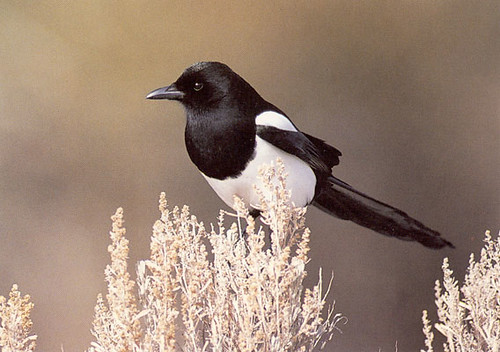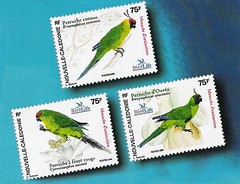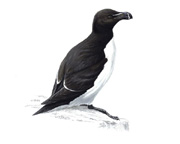Birds in the News #26

Black-billed Magpie, Pica hudsonica.
Birds in Science:
Last year, in the peer-reviewed journal Animal Cognition, behavioral biologist Thomas Bugnyar described a twist in an experiment he was conducting with laboratory ravens. The birds' job was to find bits of cheese hidden in film canisters, then pry open the lids to get the food out. But when one bird, Hugin, was more adept at finding cheese while his more dominant companion was stronger and eager to steal the prized morsels, deceit evened out the playing field. To be deceitful, Hugin had to understand that ''what I know'' and ''what he knows'' are different. Hugin had to understand, on some level, that other ravens have their own individual perceptions, feelings and plans, just as he does. This is a reminder that when it comes to mental abilities, animals aren't on the other side of a chasm: birds and dogs, as well as apes and sheep, stand with us on an intellectual continuum.
Birds' eggs are unique in their diverse pigmentation. Most passerines lay eggs that are speckled with reddish protoporphyrin spots that form a ring around the egg's blunt end, on an otherwise unpigmented shell. Why are birds' eggs speckled? Evidence in a paper by Gosler, Higham & Reynolds that will soon appear in the peer-reviewed journal, Ecology Letters, suggests that protoporphyrins strengthen the eggshell by compensating for reduced eggshell-thickness caused by calcium deficiency. Pigment spots on great tit eggs specifically marked thinner areas of shell, with darker spots marking yet thinner shell than paler spots, and females nesting on low-calcium soils, laid thinner-shelled, more-spotted eggs than those on high-calcium soils nearby. Pigmentation may offer a way to assess eggshell quality.
Birds Helping People:
A mother and her three daughters were saved from a fiery death by their screaming pet parrot, when an arsonist set fire to their home early yesterday morning. "If it was not for the noise the parrot was making we may not have been alive today. We were all asleep and we did not know what was going on," said Thakoordeen Benny, who is employed with the Ministry of Works and Transport in Trinidad and Tobago, where the arson occurred.
People Helping Birds:
 The globally threatened parakeets of New Caledonia are celebrated in a set of three postage stamps, issued by Office des Postes et Telecommunications with The New Caledonian Ornithological Society (Société Calédonienne d’Ornithologie, SCO). The Horned Parakeet, Eunymphicus cornutus, is endemic to New Caledonia and can be seen in most parts of the main island, where it feeds on seeds from the cones of the endemic species of Kauri pine, and other seeds and nuts. The closely-related Uvea Parakeet, Eunymphicus uvaeensis, is found only on the tiny island of Uvea. Introduced bees have colonised its nest sites in hollow trees, and poachers destroy the nest holes to reach young birds for the pet trade. The New Caledonian Red-crowned Parakeet, Cyanoramphus saisetti, was only recently separated from other similar red-fronted parakeets found on Pacific islands and is currently classified as Near Threatened.
The globally threatened parakeets of New Caledonia are celebrated in a set of three postage stamps, issued by Office des Postes et Telecommunications with The New Caledonian Ornithological Society (Société Calédonienne d’Ornithologie, SCO). The Horned Parakeet, Eunymphicus cornutus, is endemic to New Caledonia and can be seen in most parts of the main island, where it feeds on seeds from the cones of the endemic species of Kauri pine, and other seeds and nuts. The closely-related Uvea Parakeet, Eunymphicus uvaeensis, is found only on the tiny island of Uvea. Introduced bees have colonised its nest sites in hollow trees, and poachers destroy the nest holes to reach young birds for the pet trade. The New Caledonian Red-crowned Parakeet, Cyanoramphus saisetti, was only recently separated from other similar red-fronted parakeets found on Pacific islands and is currently classified as Near Threatened. Animal Disaster Relief News/Katrina News:
Thousands of people are feared dead in the rubble of storm-shattered New Orleans, but at the New Orleans zoo only three of its 1,400 animals died in the wrath of Hurricane Katrina. The famous Audubon Zoo has the good fortune of being located on some of the city's highest ground, but it also had a disaster plan for the animals that worked better than the city's plan for humans. The only fatalities so far were two otters and a raccoon, zoo curator Dan Maloney said on Sunday.
Perhaps you wondered if Katrina could impact migratory birds? Some ornithologists are wondering this, too. Imagine migratory birds, such as the Blackpoll Warbler - living in northern Canada, wintering in South America. Exhausted from bucking the wind, the birds - which pass through South Dakota in the spring and fall - spiral down out of the air, dead, falling into the ocean or sometimes atop oil rigs, according to Dan Tallman, who has witnessed this occurrence. In the end, Katrina could mean that early migrating birds passing through the Dakotas - including the Blackpoll Warbler and warblers in general, hummingbirds and flycatchers - will be few and far between next year, Tallman said.
People Hurting Birds:
 Seabird colonies in Scotland have suffered one of the worst breeding seasons on record, experts have warned. Reserves run by RSPB Scotland, the National Trust for Scotland (NTS) and the Scottish Wildlife Trust (SWT) have seen major breeding failures for guillemot, puffin, kittiwake and razorbill (pictured) colonies, particularly in the west coast reserves. This is important because almost half of all seabirds in the EU nest around the coast of Scotland. Stuart Housden, director of RSPB Scotland said "We believe last year's breeding failures were due to lack of food for seabirds as a result of warming seas along the east coast which are a result of climate change. [...] This is the first time the west has been affected and we can only speculate as to why but climate change must be considered as a factor."
Seabird colonies in Scotland have suffered one of the worst breeding seasons on record, experts have warned. Reserves run by RSPB Scotland, the National Trust for Scotland (NTS) and the Scottish Wildlife Trust (SWT) have seen major breeding failures for guillemot, puffin, kittiwake and razorbill (pictured) colonies, particularly in the west coast reserves. This is important because almost half of all seabirds in the EU nest around the coast of Scotland. Stuart Housden, director of RSPB Scotland said "We believe last year's breeding failures were due to lack of food for seabirds as a result of warming seas along the east coast which are a result of climate change. [...] This is the first time the west has been affected and we can only speculate as to why but climate change must be considered as a factor." Tony Fizer was on final approach to Vancouver International Airport when his SkyWest jet hit a goose. "Things happened so fast," says Fizer, SkyWest's chief pilot in Salt Lake City. "I remember a blurry thing out of the corner of my eye and then a thud on the nose. It ended up impaling itself on one of my instruments." Bird strikes are increasing at airports as passenger numbers climb, the aviation industry installs quieter engines on newer planes and wildlife populations swell. During the next two months, the canals and wetlands that flank the airport will host an estimated 500,000 wildfowl, elevating the chance of jet engines sucking in birds, and birds crashing into aircraft. That's why airports such as Salt Lake City International are heeding Federal Aviation Administration calls to stage aggressive wildlife control measures, especially during bird migration seasons. GrrlScientist note: This story was not placed in its own separate category, birds hurting people because birds are not intentionally hurting people.
Ivory-billed Woodpecker News:
A group of environmentalists is trying to block construction of two federal water projects in Arkansas, arguing they could damage the habitat of the highly endangered ivory-billed woodpecker. After an initial wave of celebration, conservation groups -- which say that the only reason the woodpecker survived this long is because the federal government abandoned a navigation project along Arkansas' Cache River in the 1970s -- say administration officials are risking driving the bird to extinction once again. "We are asking the court to stop the rush to judgment by federal agencies more determined to build the irrigation project than to consider the damage it will do to the bottomland hardwood forests where the ivory-bill was found," said David Carruth, president of the Arkansas Wildlife Federation. "The ivory-billed woodpecker reminds us that is a very special region. Protecting it means protecting an irreplaceable part of our country's wildlife heritage for future generations."
Birds on the Web:
Featured this week on the popular radio show, BirdNote; Hazel Wolf and the Brown Creeper, Certhia americana; Songbirds Leave Magpies Behind; Cedar Waxwings, Bombycillia cedrorum, Sleek and Handsome; Swallows on Wires; and The Heron and the Snake, a story by Michael Hobbs. BirdNote shows are two-minute vignettes that incorporate the rich sounds of birds with stories that illustrate the interesting — and in some cases, truly amazing — abilities of birds. BirdNote can be heard Monday through Friday, 8:58-9:00AM, throughout Western Washington and Southwest British Columbia and is also available as RSS/Podcast feeds.
This story, gigabyte birding, reviews a flock of new high technologies that are swooping in to upgrade the quiet preserve of birdwatching.
Wednesday morning, boaters and fishermen came upon a sizeable bird kill on Lake Superior between Grand Marais and Paradise Harbor. Apparently "hundreds" of small birds including Swainson's Thrushes and warblers were seen dead in the water, floating in "slicks" of debris, including birch branches with leaves still on them. The Department of Natural Resources went out there yesterday afternoon and picked up some of the carcasses, so apparently no one knows what happened yet. If anyone observed this, or has any ideas what may have happened, Laura Erickson, whose blog I linked to, would appreciate hearing from you. I also, am very interested to learn more about this, if you wish to post comments here or email updates or photographs to me, feel free to do so.
Miscellaneous Birds:
Black-billed magpies, Pica hudsonica, are common birds in Anchorage, Alaska. They can be attracted to a bird feeder in winter, and they provide hours of fascinating (or annoying) wildlife watching, according to this Anchorage Daily News story. Magpies are handsome birds that sometimes seem to have a bit in common with teenage boys -- engaging in aggressive, sometimes risky stunts like pulling hairs out of a cat or dog tail, then flying away. Tweaking a potential predator is intended to impress other magpies who are watching from a safe distance. "Really, they're no worse than New Yorkers," said Rick Sinnott, Anchorage area biologist for the Alaska Department of Fish and Game. "They're kind of obnoxious, but you've gotta love them for what they are." GrrlScientist says: New Yorkers are annoying?
Thanks to my bird pals Fred, Joy, Ellen, Ron and Ian for some of the links you are reading here.
Previous : : Birds in the News : : Next
© 2004, 2005, 2006 by GrrlScientist











6 Peer Reviews:
It's nice to check back in here and read bird news. All the hurricane news finally pushed me into outrage fatigue. Reading about birds is just good for the soul. Thanks for posting it.
Great post...especially the raven part!
Sadly, my understanding is that the wetlands outside NO are a vital migratory bird area. I'm pretty worried about the effect of toxic spills, etc, to say nothing of pumping the city dry.
Ravens are wonderfully social as well. Any experiments dealing with raven "culture" -- how they cooperate and hence necessarily share information? Used to live in Japan -- the campus I worked at in Hachioji-shi was taken over by "jungle ravens." Don't know the exact species--do know they were incredibly smart and too big to be crows. Since I used to feed the tribe of stray cats on campus, the ravens and I had numerous interactions--no harm done to any parties, but I did try to ensure that our campus cats ate first.
And I'll second RD's comment - what a nice respite from 24/7 death and political incompetence (and RD - love the Cooper's Hawk photos!).
Off topic question, if anyone has answers - I've read that hummer feeders should be cleaned with soap not bleach, and bleach not soap, both with equal emphasis. Suggestions anyone?
Also, my macaw loves chicken bones. Any chance that the hormones in the chickens could affect her?
Another great issue, GS, and I find it somehow ironic that two of the animal fatalities at the Audubon Zoo were otters; the stress alone on all the animals must have been immense though, and I'm both pleased and surprised that more weren't lost.
After Katrina hit we did do some furious googling to try and get info on migratory birds and actually had trouble turning up anything (we had been seeing many more-northern birds earlier than usual this year) so thanks for the link. I'm sure more news will emerge as time goes on...
Thanks, everyone, for appreciating our wonderful feathery friends. I have often said that life is not worth living if one has to live in a world without birds. The recent incompetence regarding our little weather disaster has made me so angry that I am almost ready to fling myself out of my chair, clawing at my eyes and throat while writhing in extreme frustration. But of course, that would not do any good for anyone, so I instead look around for bird stories for those who would like to read them, inspired by the memory of the musicians who sat on the side of the WTC pits after 911, playing Bach for the rescuers/recovery teams.
ThomH; I am always looking for great bird stories to link to and tell, and I do know that ravens are the subject of several research projects out there, so hopefully there will be some published stories out there to link to.
Incidentally, I know exactly the birds ("Jungle Ravens") that you speak of ... when I was in Tokyo, I also met these birds and was impressed by them.
Jamie; you can use either soap or bleach or (horrors!) both to clean a hummingbird feeder without a problem. Just be sure to rinse it well afterwards to remove soap/bleach residues.
I am not sure if the hormones in chicken bones would hurt your macaw .. maybe? Certainly, cooking should denature most hormones, but I am no expert on matters such as this.
GrrlScientist
Post a Comment
<< Home